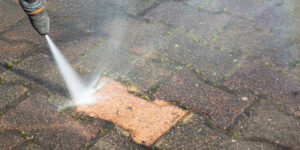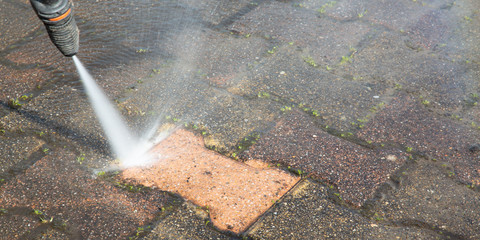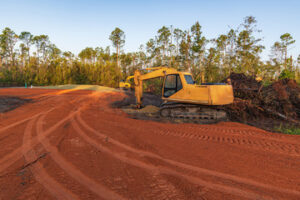Pressure Washing Austin can make short work of stubborn stains, built-up dirt and even mildew or mold. It’s a great method for cleaning driveways, sidewalks and outdoor patios.

However, it’s important to use the proper nozzle and water temperature for the surface you are cleaning. Otherwise, you could damage your surfaces and cause injury.
Pressure washing is a cleaning method that uses high-pressure water spray to remove dirt, grime, and other debris from surfaces such as concrete, brick, and wood. It can also be used to remove moss, mildew, and mould from exterior structures such as buildings, patio furniture, decks, swimming pools, farm equipment, and other outdoor surfaces. In some cases, detergents or other chemical solutions can be added to the water stream to improve its effectiveness and reduce the amount of pressure needed to clean a particular surface.
Before beginning a pressure washing project, it’s important to scan the area and take note of any shrubs, trees, bushes, or other features that could be damaged by the high-pressure spray. A drop cloth or plastic tablecloth can be placed over any delicate areas to prevent damage. It’s also a good idea to check your pressure washer’s user manual for instructions on relieving the pressure, draining the pump, and storing the machine.
The high-pressure water from a pressure washer can be used to safely clean most outdoor surfaces, though it’s important to use the correct settings and technique for each surface type. For example, a surface cleaner attachment or turbo nozzle can help avoid damaging porous surfaces like brick and stone while also providing better control of the water flow.
While pressure washing is ideal for routine maintenance and cleaning mildly dirty concrete surfaces, it’s not as effective at removing oil stains or grease. A power washer, on the other hand, is equipped with heated water and is more effective at breaking down these contaminants. It’s also the best choice for cleaning surfaces that are sensitive to heat, such as vinyl siding and windows.
What is the Difference Between Power Washing and Pressure Washing?
Whether you are a homeowner looking to boost curb appeal or a business owner aiming for a fresh and welcoming appearance, a power wash is the perfect solution. This cleaning technique is able to revive and restore hardscapes and exterior surfaces, breathing new life into them with just a burst of high-pressure water. Over time, natural elements like dirt, dust, and mildew erode and discolor outdoor materials like concrete, brick, asphalt, and wood, leaving behind unsightly stains and potentially dangerous hazards. Power washing removes these contaminants and prevents them from re-occurring, improving safety and overall aesthetics.
A power wash uses a high-pressure water stream to clean surfaces that are not sensitive to heat, such as concrete and brick. Unlike regular water hoses, which produce about 60 PSI, power washers have multiple nozzles that vary the size of the water jets, allowing you to control how much pressure is applied. The most powerful nozzle on a power washer has the least holes and highest pressure, while the smallest nozzles have more holes and lower pressure.
Power washing is a great option for intensive cleaning tasks and heavy-duty cleanups, such as removing oil, grease, and grime from large industrial surfaces or heavily soiled exterior walls. It also helps to restore the appearance of surfaces that have been discolored over time, such as a faded deck or moss-covered patio. However, power washing is not suitable for all surfaces, as the forceful water flow can damage or wear away softer materials. For this reason, it is important to choose a professional service that knows how to properly use a power washer and understands which surfaces can withstand its high-pressure waters.
Why Should I Hire a Professional?
Many homeowners today are embracing the do-it-yourself (DIY) movement. While this is great for most projects, there are some tasks that are better left to professionals, and pressure washing is one of them. Professional pressure washing services will clean your surfaces more thoroughly and more efficiently than you could do on your own, saving you time, energy, and money.
Additionally, a professional knows how to use the proper settings on the power washer and what cleaning solutions are best for different surfaces. This ensures that your surfaces are cleaned without being damaged or having the wrong chemicals used. A professional also has experience in working on various surface types and will be able to identify any potential issues with the surface that may need attention before proceeding.
The results of a professional pressure wash will be long-lasting and will provide a fresh, new look to your home or business. Dirty surfaces are not just unsightly; they can harbor bacteria and allergens that can be harmful to the health of those who live or work in a space. A regular cleaning with a power washer can remove mold, mildew, and dirt that leads to these contaminants and creates a healthier environment for the occupants.
A regularly scheduled professional pressure wash can also help with maintenance and preventative care for your property. The pressure washer can uncover any underlying problems, such as a leaking roof or loose siding, which will save you from spending much more money later on. In addition, the regular cleaning of your roof can help prevent moss from growing and degrading your shingles over time.
A professional can also prepare your home or business for a paint job or other renovations by professionally cleaning the surfaces with a power washer before beginning the work. This can make the job go much faster and more smoothly, and will result in a beautiful finish for your project.
How Can I Save Money on Pressure Washing?
Pressure washing is a great way to keep exterior surfaces clean and free from dirt, mold, mildew, and grime that can damage and shorten their lifespan. It also helps to prevent health hazards such as allergens and bacteria that can be spread from dirty exterior surfaces. Keeping your home’s exterior clean can also save you money on energy bills by eliminating the buildup of heat-trapping layers that can increase your reliance on heating and cooling systems.
Professionals use specialized equipment that allows them to clean surfaces like brick, concrete and wood siding more thoroughly than a standard garden hose. They can also handle tough stains like oil and grease that are normally difficult to remove without damaging the surface. They can also safely clean gutters and drainpipes, preventing blockages and clogs that can lead to costly repairs.
A well-maintained and spotless exterior can make a huge difference in your business’s image and customer perception. Regular pressure cleaning will help to remove any stains, debris and grime that may be causing your business to appear unprofessional and careless. A clean and pristine exterior will show potential customers that you are organized and dedicated to your business.
Unlike other cleaning methods that can be time-consuming and tedious, pressure washing is fast, efficient, and effective. It can save you both time and money in the long run by preventing costly repairs, improving efficiency, and boosting curb appeal. Invest in professional pressure washing and start saving money today!
How Can I Damage My Home or Business?
Pressure washing can be a very dangerous process, especially in the hands of someone who isn’t familiar with how to use the equipment. A strong jet of water can cause injury if it hits your head or eyes, and wastewater that isn’t properly disposed of damages the environment. This is why it’s best to leave the job to a professional cleaning company that knows how to handle and operate a power washer safely.
It’s also important to understand how a pressure washer works and the limits of its strength before attempting a DIY project. Choosing the wrong nozzle or using too much water pressure can damage your property. Some surfaces, like concrete parking lots, can withstand very high levels of pressure, but others, such as wood or vinyl siding, aren’t designed to be exposed to such force.
In addition to causing potential structural damage, too much pressure can spray up under the shingles on your roof and cause leaks in your home. It can also strip the protective granules off of asphalt shingles and cause them to break down, which can lead to mold and mildew growth and other issues.
Other risks of DIY pressure washing include directing the stream of water directly at plants and animals, which can cause them harm. It’s important to always stand a safe distance away from any living plants when using a power washer, and it’s a good idea to cover them with tarps or other barriers before beginning the cleaning process. Finally, it’s crucial to be careful around electrical fixtures, as high-pressure water can cause them to deteriorate or even burst.
Fortunately, professional power washing services can keep your property looking new and help prevent major problems from developing. Regular cleanings can uncover the beauty of your building’s surface, improve safety and curb appeal, and boost your business’s value.






